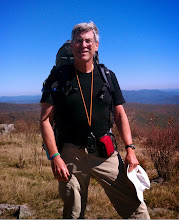On this date, eight years in remission from Hodgkin lymphoma, I thought I would look back on 2010 and write about eight great memories I have had in the great ourdoors this year. These are not in any particular ranking order. If you want to read about my eight great moments racing for a cure in 2010, click here.
1. Rip Rap Hollow hike. Every summer since 2003, I do this wonderful hike to celebrate still being on God’s green earth with enough strength to hike. Rip Rap Hollow was my first post-cancer hike, and it is a beautiful one. I know some day, I will do this hike for the last time, but I hope that won’t be for a while. I often see wildlife on the hike, but not this time.
2. Hiking in Mount Rainier National Park. Wow, hard to top this! After the Seattle half-marathon in June, I left Seattle and my teammates behind and struck out on my own for three days of hiking. I was tired and my left foot hurt like crazy, and there was deep snow everywhere over 4,500 feet, but I think I did about 25 miles of hiking in many parts of the southern section of this park. As a bonus, I had incredible views of Rainier one day.
3. Seeing a lynx. We were driving past Denali National Park in September on the way to a restaurant. Suddenly, like a vision, a tall, gangly cat ran across the road in front of the car through the rain – a Canada lynx! He disappeared into the thick brush in seconds, but the image endures of the first feline I have ever seen in the wild.
4. Backpacking the Priest. I’ve been wanting to try backpacking again for years, and did just over a month ago, doing a circuit hike through the Priest Wilderness in SW Virginia. It was definitely one of my great outdoor moments this year, and I need to do it again in 2011. Man, it was cold, though.
5. The starry night. My friend and I camped at the summit of Priest Mountain on the backpacking trip on that cold, clear night. The wind was howling and we huddled around our little fire after gulping down dinner. I looked up, and realized that the stars were just amazing. We walked out on rocks to get a clear view and were both awestruck with their brilliance. The word awesome is much overused, but this truly was awesome.
6. Cruising the Kenai Fjords. While in Alaska, we did a one day wildlife cruise in Kenai Fjords National Park, and it was incredible. Not only was the scenery spectacular with all the mountains, glaciers, and islands, but we saw incredible marine wildlife. Some of the new species we viewed were Steller’s sea lions, Dall porpoises, fin whale, humpbacked whale, tufted and horned puffins, and sea otters.
7. Wildlife in Denali National Park. About a week after seeing the Kenai Fjords, we took an all day wilderness bus tour in Denali. Again, the scenery was spectacular, as was the wildlife viewing. We saw Dall sheep, caribou, grizzly bear, moose, and wolves, along with a few less impressive species. Our day included seeing three wolves chasing Dall sheep across a sheer cliff.
8. Beta Testing the DeLorme PN-60 GPS. From March through August, I was a beta tester for the new DeLorme PN-60 GPS that synchs up with a SPOT satellite messenger, along with DeLormes impressive Topo USA 9 software. I did a variety of tests all over the place, including Washington State while I was there. It was fun to participate with this, and as a reward, I recently received a production PN-60, the SPOT, a year subscription to the messaging service, and the Topo USA software. I recommend you check this GPS out. DeLorme has received national awards for these products.
Mesothelioma Lawyer Center
7 years ago
















 At the end of the trail, we started walking along the the road 4.5 miles back to the car, virtually all up hill. We hitch-hiked as we walked, and after a mile and a half, a couple stopped and gave us a ride to the fish hatchery. What a huge help that was. Our trip was over. It had seemed like a good idea a month ago, and despite the cold, it had turned out that way!
At the end of the trail, we started walking along the the road 4.5 miles back to the car, virtually all up hill. We hitch-hiked as we walked, and after a mile and a half, a couple stopped and gave us a ride to the fish hatchery. What a huge help that was. Our trip was over. It had seemed like a good idea a month ago, and despite the cold, it had turned out that way! We lucked out with the dry weather because I could place various gear around while setting up my tent. I had to rummage through my pack to find things I needed. We got the tents up with our sleeping gear organized just before dark. By then, I had also put on long underwear, gloves, a hat, and all my top layers because it got colder and colder.
We lucked out with the dry weather because I could place various gear around while setting up my tent. I had to rummage through my pack to find things I needed. We got the tents up with our sleeping gear organized just before dark. By then, I had also put on long underwear, gloves, a hat, and all my top layers because it got colder and colder.




























 And here is the track of the circuit, mapped in DeLorme's Topo USA 9.0:
And here is the track of the circuit, mapped in DeLorme's Topo USA 9.0:













